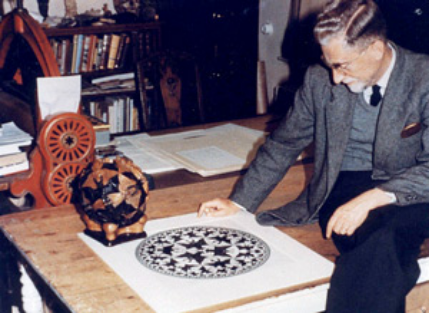Escher`s mathematical art
The mathematical ideas behind their work
The dutch artist M.C. Escher, is well know round the world, by their artistic works with a strong inspiration on mathematical concepts. Some of them are based in their own studies, and some others in the studies and suggestions of mathematicians like Roger Penrose, George Pólya and H.S.M. Coxeter. With the last one he maintained fruitful contacts.
In their extensive graphic work they appear multiple mathematical ideas: Symmetries, regular or stellated polyhedra, tessellations, topology, spherical geometry and impossible objects, between others. But something that he always pursued was the representation of the idea of infinity. This guided his steps towards hyperbolic geometry.
M.C. Escher, looking at one of his works

Chasing non-euclidean universes
One of their first encounters with hyperbolic geometry was at 1956. From that date, he produces several artworks based on the representation of the hyperbolic plane. And also some more with a less clear mathematical idea behind that, but also pursuing the representation of infinity.
In this geometry, as in the spherical geometry also, they are not valid the same principles that are valid in euclidean geometry. He achieved more and more perfection, with graphic works in a mixture of styles, Op-art (Optical Art) and Surrealism.
He maintained other constant of their work, that of tessellation, which he learned from Pólya, but now in the new spaces. The idea of infinity is represented in the limit as a smaller and smaller drawings, which could not have been done without great virtuosity on their part.